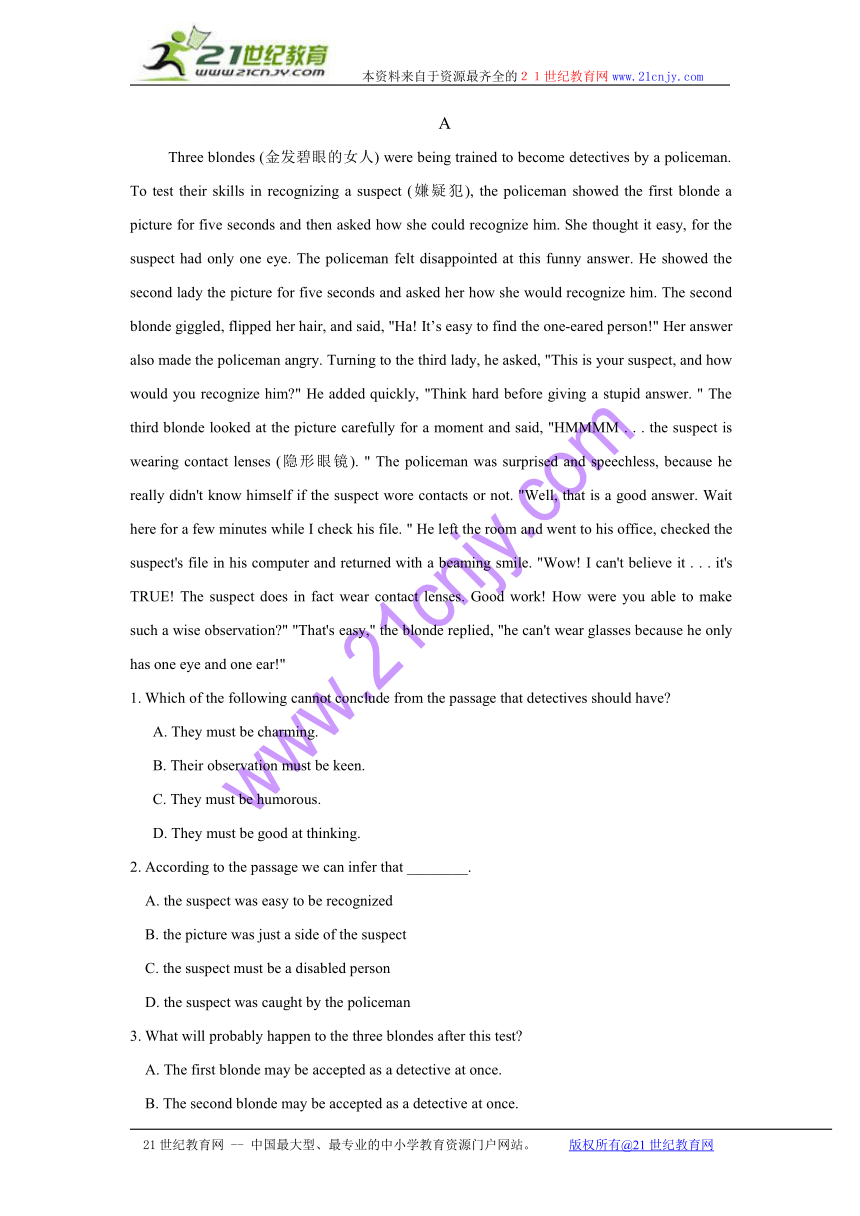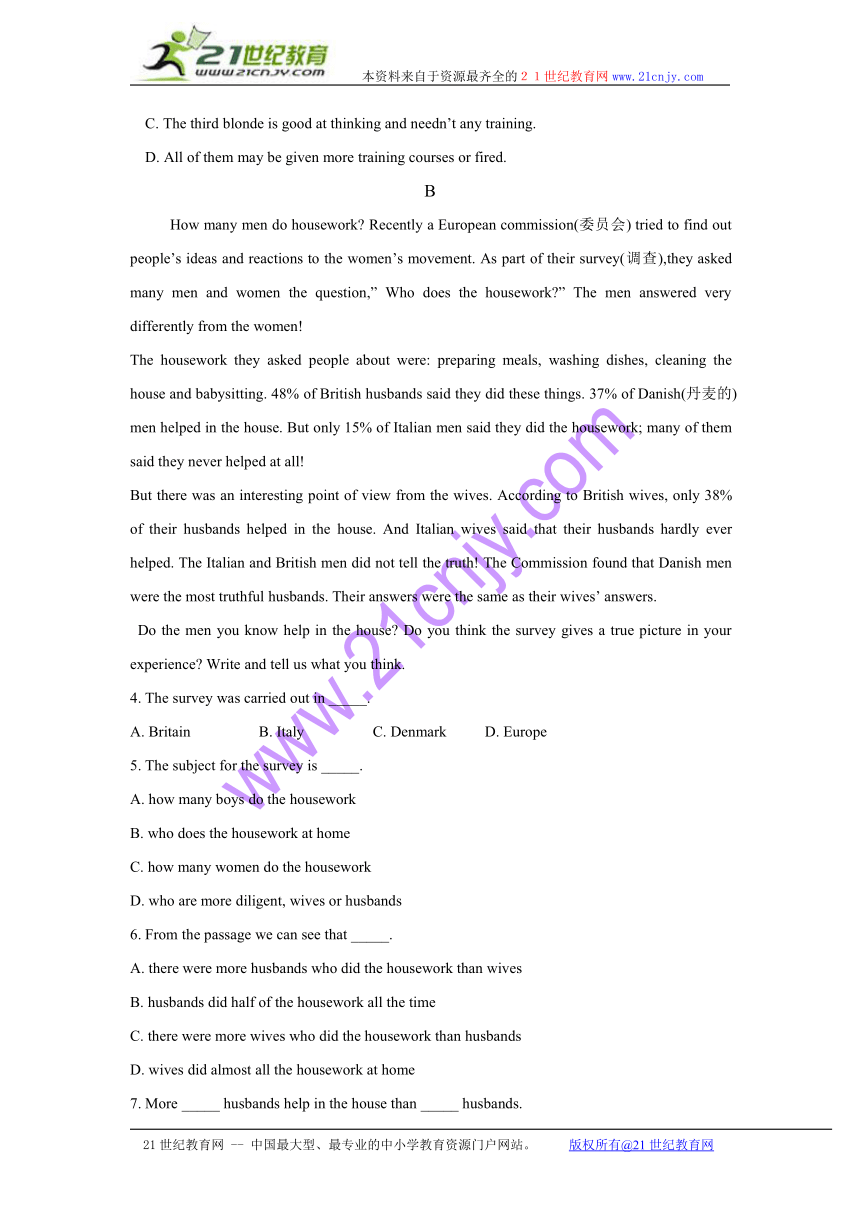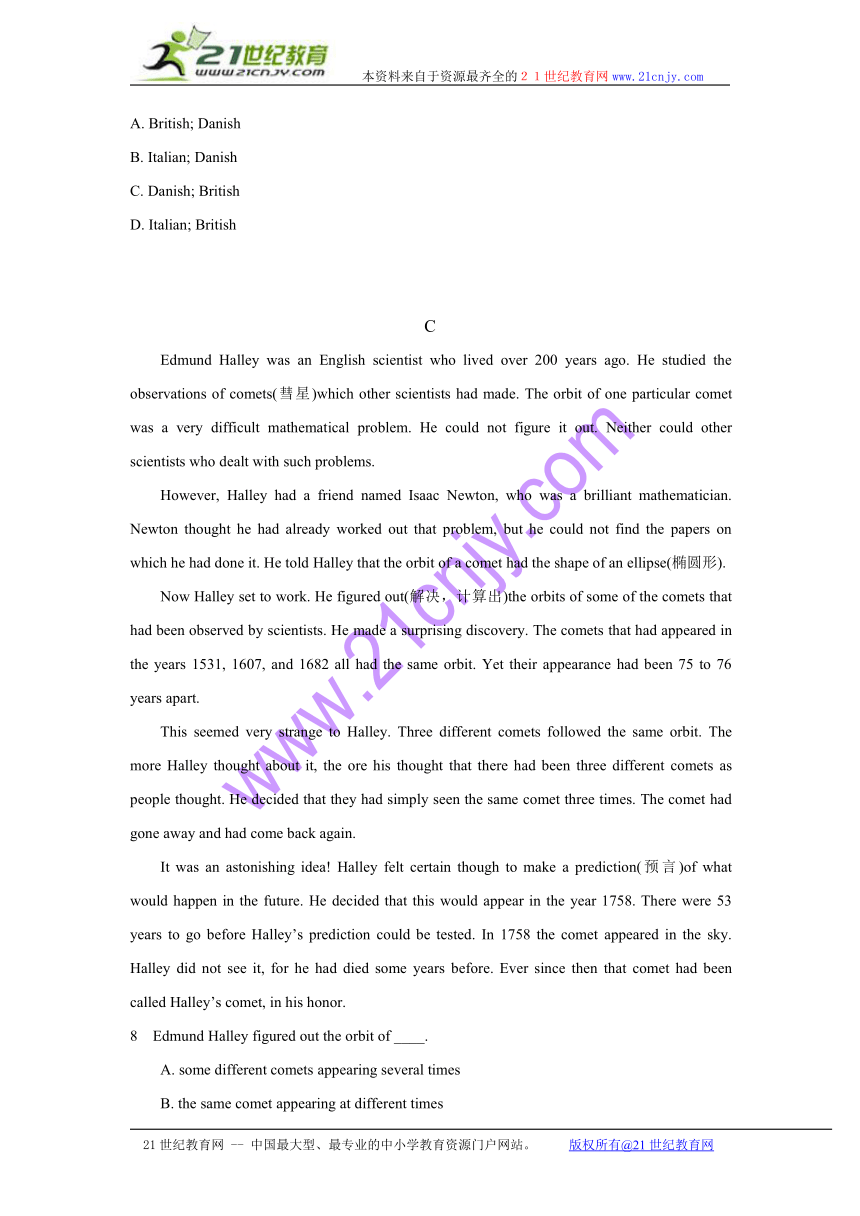高二人教版阅读专题训练(6)
文档属性
| 名称 | 高二人教版阅读专题训练(6) |

|
|
| 格式 | rar | ||
| 文件大小 | 15.8KB | ||
| 资源类型 | 教案 | ||
| 版本资源 | 人教版(新课程标准) | ||
| 科目 | 英语 | ||
| 更新时间 | 2011-02-23 16:07:00 | ||
图片预览



文档简介
A
Three blondes (金发碧眼的女人) were being trained to become detectives by a policeman. To test their skills in recognizing a suspect (嫌疑犯), the policeman showed the first blonde a picture for five seconds and then asked how she could recognize him. She thought it easy, for the suspect had only one eye. The policeman felt disappointed at this funny answer. He showed the second lady the picture for five seconds and asked her how she would recognize him. The second blonde giggled, flipped her hair, and said, "Ha! It’s easy to find the one-eared person!" Her answer also made the policeman angry. Turning to the third lady, he asked, "This is your suspect, and how would you recognize him?" He added quickly, "Think hard before giving a stupid answer. " The third blonde looked at the picture carefully for a moment and said, "HMMMM . . . the suspect is wearing contact lenses (隐形眼镜). " The policeman was surprised and speechless, because he really didn't know himself if the suspect wore contacts or not. "Well, that is a good answer. Wait here for a few minutes while I check his file. " He left the room and went to his office, checked the suspect's file in his computer and returned with a beaming smile. "Wow! I can't believe it . . . it's TRUE! The suspect does in fact wear contact lenses. Good work! How were you able to make such a wise observation?" "That's easy," the blonde replied, "he can't wear glasses because he only has one eye and one ear!"
1. Which of the following cannot conclude from the passage that detectives should have?
A. They must be charming.
B. Their observation must be keen.
C. They must be humorous.
D. They must be good at thinking.
2. According to the passage we can infer that ________.
A. the suspect was easy to be recognized
B. the picture was just a side of the suspect
C. the suspect must be a disabled person
D. the suspect was caught by the policeman
3. What will probably happen to the three blondes after this test?
A. The first blonde may be accepted as a detective at once.
B. The second blonde may be accepted as a detective at once.
C. The third blonde is good at thinking and needn’t any training.
D. All of them may be given more training courses or fired.
B
How many men do housework? Recently a European commission(委员会) tried to find out people’s ideas and reactions to the women’s movement. As part of their survey(调查),they asked many men and women the question,” Who does the housework?” The men answered very differently from the women!?
The housework they asked people about were: preparing meals, washing dishes, cleaning the house and babysitting. 48% of British husbands said they did these things. 37% of Danish(丹麦的) men helped in the house. But only 15% of Italian men said they did the housework; many of them said they never helped at all! ?
But there was an interesting point of view from the wives. According to British wives, only 38% of their husbands helped in the house. And Italian wives said that their husbands hardly ever helped. The Italian and British men did not tell the truth! The Commission found that Danish men were the most truthful husbands. Their answers were the same as their wives’ answers. ?
Do the men you know help in the house? Do you think the survey gives a true picture in your experience? Write and tell us what you think. ?
4. The survey was carried out in _____. ?
A. Britain B. Italy? C. Denmark D. Europe?
5. The subject for the survey is _____. ?
A. how many boys do the housework?
B. who does the housework at home?
C. how many women do the housework?
D. who are more diligent, wives or husbands?
6. From the passage we can see that _____. ?
A. there were more husbands who did the housework than wives?
B. husbands did half of the housework all the time?
C. there were more wives who did the housework than husbands?
D. wives did almost all the housework at home?
7. More _____ husbands help in the house than _____ husbands. ?
A. British; Danish
B. Italian; Danish?
C. Danish; British
D. Italian; British?
C
Edmund Halley was an English scientist who lived over 200 years ago. He studied the observations of comets(彗星)which other scientists had made. The orbit of one particular comet was a very difficult mathematical problem. He could not figure it out. Neither could other scientists who dealt with such problems.
However, Halley had a friend named Isaac Newton, who was a brilliant mathematician. Newton thought he had already worked out that problem, but he could not find the papers on which he had done it. He told Halley that the orbit of a comet had the shape of an ellipse(椭圆形).
Now Halley set to work. He figured out(解决,计算出)the orbits of some of the comets that had been observed by scientists. He made a surprising discovery. The comets that had appeared in the years 1531, 1607, and 1682 all had the same orbit. Yet their appearance had been 75 to 76 years apart.
This seemed very strange to Halley. Three different comets followed the same orbit. The more Halley thought about it, the ore his thought that there had been three different comets as people thought. He decided that they had simply seen the same comet three times. The comet had gone away and had come back again.
It was an astonishing idea! Halley felt certain though to make a prediction(预言)of what would happen in the future. He decided that this would appear in the year 1758. There were 53 years to go before Halley’s prediction could be tested. In 1758 the comet appeared in the sky. Halley did not see it, for he had died some years before. Ever since then that comet had been called Halley’s comet, in his honor.
8 Edmund Halley figured out the orbit of ____.
A. some different comets appearing several times
B. the same comet appearing at different times
C. three different comets appearing at the same time
D. several comets appearing at the same time
9. Halley made his discovery ____.
A. by doing experiments
B. by means of his own careful observation
C. by using the working of other scientists
D. by chance
10. Halley made a surprising, but correct prediction in the year____.
A. 1704 B. 1705 C. 1706 D. 1707
11. This passage in general is about ____.
A. Halley and other scientists
B. the orbit of a comet
C. Newton and Halley
D. Halley and his discovery
12. Which of the following is TRUE?
A. Edmund Halley was an American scientist.
B. Halley made his discovery by doing experiments.
C. Isaac Newton was a famous mathematician.
D. The orbit of a comet had the shape of an around.
1. C
解析:警察之所以培训这样的女士,首先是因为她们的长相,但单凭这些是不能胜任侦探工作的,她们还要有敏锐的观察和分析能力。是否需要幽默,文中并没有提到。
2. B
解析:第一个女孩看到嫌疑犯只有“一只眼睛”,第二个女孩看到只有“一个耳朵”,警察对这两个人的回答都感到滑稽、可笑,由此可以推测这张画像是一个人的侧面照。
3. D
解析:她们本来就是在接受训练,而对于这次测试的结果,可以看出三个人目前在这方面是没有什么值得称赞的,所以继续培训或被解雇的可能性都存在。
4. D
解析:从文章第一段提到的委员会及相应的国家可知答案。?
5. B
解析:这正是调查的目的。?
6. C
解析:这是事实,也是社会常识。?
7. A
解析:综合推理题。比较文章二段中的一组数字可知答案。
8. B
解析:这是一道综合判断题。根据文章的第四段“He decided that they had simply seen the same comet three times. ”及上文提到的看彗星的时间分别是1531年、1607年、1682年可判断正确答案为选项B。
9. C
解析:这是一道细节理解题。根据文章第一段“He studied the observations of comets which other scientists had made. ”可知,哈雷的发现是在研究其他科学家们的观察中得出来的。
10. B
解析:这是一道计算题。文中的“He decided that this would appear in the year 1758. There were 53 years to go before Halley’s prediction could be tested. ”这句话告诉我们:他预言彗星出现的时间是1758年,而这个预言还要经过53年才能验证,由此可以推断出哈雷做出这个预言的时间是1705年。
11. D
解析:这是一道主旨大意题。纵观全文,不难看出,文章的中心就是哈雷以及他的发现。
12 C
解析:这是一道综合判断题。从文章首句可以看出A项错误;从第二题的分析中可知B项也错误;牛顿告诉哈雷彗星的轨道是椭圆形的,可排除D。
Three blondes (金发碧眼的女人) were being trained to become detectives by a policeman. To test their skills in recognizing a suspect (嫌疑犯), the policeman showed the first blonde a picture for five seconds and then asked how she could recognize him. She thought it easy, for the suspect had only one eye. The policeman felt disappointed at this funny answer. He showed the second lady the picture for five seconds and asked her how she would recognize him. The second blonde giggled, flipped her hair, and said, "Ha! It’s easy to find the one-eared person!" Her answer also made the policeman angry. Turning to the third lady, he asked, "This is your suspect, and how would you recognize him?" He added quickly, "Think hard before giving a stupid answer. " The third blonde looked at the picture carefully for a moment and said, "HMMMM . . . the suspect is wearing contact lenses (隐形眼镜). " The policeman was surprised and speechless, because he really didn't know himself if the suspect wore contacts or not. "Well, that is a good answer. Wait here for a few minutes while I check his file. " He left the room and went to his office, checked the suspect's file in his computer and returned with a beaming smile. "Wow! I can't believe it . . . it's TRUE! The suspect does in fact wear contact lenses. Good work! How were you able to make such a wise observation?" "That's easy," the blonde replied, "he can't wear glasses because he only has one eye and one ear!"
1. Which of the following cannot conclude from the passage that detectives should have?
A. They must be charming.
B. Their observation must be keen.
C. They must be humorous.
D. They must be good at thinking.
2. According to the passage we can infer that ________.
A. the suspect was easy to be recognized
B. the picture was just a side of the suspect
C. the suspect must be a disabled person
D. the suspect was caught by the policeman
3. What will probably happen to the three blondes after this test?
A. The first blonde may be accepted as a detective at once.
B. The second blonde may be accepted as a detective at once.
C. The third blonde is good at thinking and needn’t any training.
D. All of them may be given more training courses or fired.
B
How many men do housework? Recently a European commission(委员会) tried to find out people’s ideas and reactions to the women’s movement. As part of their survey(调查),they asked many men and women the question,” Who does the housework?” The men answered very differently from the women!?
The housework they asked people about were: preparing meals, washing dishes, cleaning the house and babysitting. 48% of British husbands said they did these things. 37% of Danish(丹麦的) men helped in the house. But only 15% of Italian men said they did the housework; many of them said they never helped at all! ?
But there was an interesting point of view from the wives. According to British wives, only 38% of their husbands helped in the house. And Italian wives said that their husbands hardly ever helped. The Italian and British men did not tell the truth! The Commission found that Danish men were the most truthful husbands. Their answers were the same as their wives’ answers. ?
Do the men you know help in the house? Do you think the survey gives a true picture in your experience? Write and tell us what you think. ?
4. The survey was carried out in _____. ?
A. Britain B. Italy? C. Denmark D. Europe?
5. The subject for the survey is _____. ?
A. how many boys do the housework?
B. who does the housework at home?
C. how many women do the housework?
D. who are more diligent, wives or husbands?
6. From the passage we can see that _____. ?
A. there were more husbands who did the housework than wives?
B. husbands did half of the housework all the time?
C. there were more wives who did the housework than husbands?
D. wives did almost all the housework at home?
7. More _____ husbands help in the house than _____ husbands. ?
A. British; Danish
B. Italian; Danish?
C. Danish; British
D. Italian; British?
C
Edmund Halley was an English scientist who lived over 200 years ago. He studied the observations of comets(彗星)which other scientists had made. The orbit of one particular comet was a very difficult mathematical problem. He could not figure it out. Neither could other scientists who dealt with such problems.
However, Halley had a friend named Isaac Newton, who was a brilliant mathematician. Newton thought he had already worked out that problem, but he could not find the papers on which he had done it. He told Halley that the orbit of a comet had the shape of an ellipse(椭圆形).
Now Halley set to work. He figured out(解决,计算出)the orbits of some of the comets that had been observed by scientists. He made a surprising discovery. The comets that had appeared in the years 1531, 1607, and 1682 all had the same orbit. Yet their appearance had been 75 to 76 years apart.
This seemed very strange to Halley. Three different comets followed the same orbit. The more Halley thought about it, the ore his thought that there had been three different comets as people thought. He decided that they had simply seen the same comet three times. The comet had gone away and had come back again.
It was an astonishing idea! Halley felt certain though to make a prediction(预言)of what would happen in the future. He decided that this would appear in the year 1758. There were 53 years to go before Halley’s prediction could be tested. In 1758 the comet appeared in the sky. Halley did not see it, for he had died some years before. Ever since then that comet had been called Halley’s comet, in his honor.
8 Edmund Halley figured out the orbit of ____.
A. some different comets appearing several times
B. the same comet appearing at different times
C. three different comets appearing at the same time
D. several comets appearing at the same time
9. Halley made his discovery ____.
A. by doing experiments
B. by means of his own careful observation
C. by using the working of other scientists
D. by chance
10. Halley made a surprising, but correct prediction in the year____.
A. 1704 B. 1705 C. 1706 D. 1707
11. This passage in general is about ____.
A. Halley and other scientists
B. the orbit of a comet
C. Newton and Halley
D. Halley and his discovery
12. Which of the following is TRUE?
A. Edmund Halley was an American scientist.
B. Halley made his discovery by doing experiments.
C. Isaac Newton was a famous mathematician.
D. The orbit of a comet had the shape of an around.
1. C
解析:警察之所以培训这样的女士,首先是因为她们的长相,但单凭这些是不能胜任侦探工作的,她们还要有敏锐的观察和分析能力。是否需要幽默,文中并没有提到。
2. B
解析:第一个女孩看到嫌疑犯只有“一只眼睛”,第二个女孩看到只有“一个耳朵”,警察对这两个人的回答都感到滑稽、可笑,由此可以推测这张画像是一个人的侧面照。
3. D
解析:她们本来就是在接受训练,而对于这次测试的结果,可以看出三个人目前在这方面是没有什么值得称赞的,所以继续培训或被解雇的可能性都存在。
4. D
解析:从文章第一段提到的委员会及相应的国家可知答案。?
5. B
解析:这正是调查的目的。?
6. C
解析:这是事实,也是社会常识。?
7. A
解析:综合推理题。比较文章二段中的一组数字可知答案。
8. B
解析:这是一道综合判断题。根据文章的第四段“He decided that they had simply seen the same comet three times. ”及上文提到的看彗星的时间分别是1531年、1607年、1682年可判断正确答案为选项B。
9. C
解析:这是一道细节理解题。根据文章第一段“He studied the observations of comets which other scientists had made. ”可知,哈雷的发现是在研究其他科学家们的观察中得出来的。
10. B
解析:这是一道计算题。文中的“He decided that this would appear in the year 1758. There were 53 years to go before Halley’s prediction could be tested. ”这句话告诉我们:他预言彗星出现的时间是1758年,而这个预言还要经过53年才能验证,由此可以推断出哈雷做出这个预言的时间是1705年。
11. D
解析:这是一道主旨大意题。纵观全文,不难看出,文章的中心就是哈雷以及他的发现。
12 C
解析:这是一道综合判断题。从文章首句可以看出A项错误;从第二题的分析中可知B项也错误;牛顿告诉哈雷彗星的轨道是椭圆形的,可排除D。
同课章节目录
